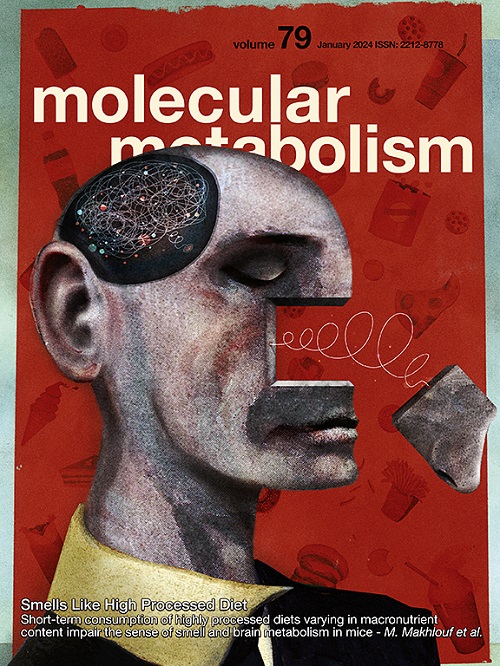Peptidylglycine alpha-amidating monooxygenase is important in mice for beta-cell cilia formation and insulin secretion but promotes diabetes risk through beta-cell independent mechanisms
IF 6.6
2区 医学
Q1 ENDOCRINOLOGY & METABOLISM
引用次数: 0
Abstract
Objectives
Carriers of PAM (peptidylglycine alpha-amidating monooxygenase) coding variant alleles have reduced insulinogenic index, higher risk of developing type 2 diabetes (T2D), and islets from heterozygous carriers of the PAM p.Asp563Gly variant display reduced insulin secretion. Exactly how global PAM deficiency contributes to hyperglycemia remains unclear. PAM is the only enzyme capable of converting glycine-extended peptide hormones into amidated products. Like neuropeptide Y (NPY), α-melanocyte stimulating hormone (αMSH), and glucagon-like peptide 1 (GLP-1), islet amyloid polypeptide (IAPP), a beta cell peptide that forms islet amyloid in type 2 diabetes, is a PAM substrate. We hypothesized that Pam deficiency limited to beta cells would lead to reduced insulin secretion, prevent the production of amidated IAPP, and reveal the extent to which loss of Pam in β-cells could accelerate the onset of hyperglycemia in mice.
Methods
PAM activity was assessed in human islets from donors based on their PAM genotype. We generated beta cell-specific Pam knockout (Ins1Cre/+, Pamfl/fl; βPamKO) mice and performed islet culture, histological, and metabolic assays to evaluate the physiological roles of Pam in beta cells. We analyzed human IAPP (hIAPP) amyloid fibril forming kinetics using synthetic amidated and non-amidated hIAPP peptides, and generated hIAPP knock-in beta cell-specific Pam knockout (hIAPPw/w βPamKO) mice to determine the impact of hIAPP amidation on islet amyloid burden, islet graft survival, and glucose tolerance.
Results
PAM enzyme activity was significantly reduced in islets from donors with the PAM p. Asp563Gly T2D-risk allele. Islets from βPamKO mice had impaired second-phase glucose- and KCl-induced insulin secretion. Beta cells from βPamKO mice had larger dense-core granules and fewer and shorter cilia. Interestingly, non-amidated hIAPP was less fibrillogenic in vitro, and high glucose-treated hIAPPw/w βPamKO islets had reduced amyloid burden. Despite these changes in beta cell function, βPamKO mice were not more susceptible to diet-induced hyperglycemia. In vitro beta cell death and in vivo islet graft survival remained comparable between hIAPPw/w βPamKO and hIAPPw/w islets. Surprisingly, aged hIAPPw/w βPamKO mice had improved insulin secretion and glucose tolerance.
Conclusions
Eliminating Pam expression only in beta cells leads to morphological changes in insulin granules, reduced insulin secretion, reduced hIAPP amyloid burden and altered ciliogenesis. However, in mice beta-cell Pam deficiency has no impact on the development of diet- or hIAPP-induced hyperglycemia. Our data are consistent with current studies revealing ancient, highly conserved roles for peptidergic signaling in the coordination of the diverse signals needed to regulate fundamental processes such as glucose homeostasis.
肽酰甘氨酸酰胺化单加氧酶对小鼠β细胞纤毛形成和胰岛素分泌很重要,但通过β细胞独立机制提高糖尿病风险。
目的:携带PAM(肽酰甘氨酸α -酰胺化单加氧酶)编码变异等位基因的人胰岛素生成指数降低,发生2型糖尿病(T2D)的风险增加,而携带PAM p.Asp563Gly变异的杂合携带者的胰岛胰岛素分泌减少。目前尚不清楚全局PAM缺乏是如何导致高血糖的。PAM是唯一能够将甘氨酸延伸肽激素转化为修饰产物的酶。与神经肽Y (NPY)、α-促黑素细胞激素(α - msh)和胰高血糖素样肽1 (GLP-1)一样,胰岛淀粉样多肽(IAPP)是2型糖尿病患者形成胰岛淀粉样蛋白的一种β细胞肽,是PAM底物。我们假设,仅限于β细胞的Pam缺乏会导致胰岛素分泌减少,阻止修饰IAPP的产生,并揭示β细胞中Pam缺失可在多大程度上加速小鼠高血糖的发生。方法:根据PAM基因型测定供体胰岛中PAM活性。我们产生了β细胞特异性Pam敲除(Ins1Cre/+, Pamfl/fl;并进行胰岛培养、组织学和代谢分析,以评估Pam在β细胞中的生理作用。我们使用合成的经修饰和未修饰的hIAPP肽分析了人类IAPP (hIAPP)淀粉样蛋白纤维形成动力学,并产生hIAPP敲入β细胞特异性Pam敲除(hIAPPw/w βPamKO)小鼠,以确定hIAPP酰胺化对胰岛淀粉样蛋白负荷、胰岛移植物存活和葡萄糖耐量的影响。结果:携带PAM p.Asp563Gly t2d风险等位基因的供体胰岛的PAM酶活性显著降低。βPamKO小鼠胰岛的第二阶段葡萄糖和KCl诱导的胰岛素分泌受损。βPamKO小鼠的β细胞具有更大的密核颗粒和更少、更短的纤毛。有趣的是,未经修饰的hIAPP在体外较少发生纤维原性,高糖处理的hIAPPw/w βPamKO胰岛减少了淀粉样蛋白负荷。尽管β细胞功能发生了这些变化,但βPamKO小鼠并不更容易受到饮食诱导的高血糖的影响。在hIAPPw/w βPamKO和hIAPPw/w胰岛之间,体外β细胞死亡和体内胰岛移植存活率保持可比性。令人惊讶的是,老年hIAPPw/w βPamKO小鼠的胰岛素分泌和葡萄糖耐量都有所改善。结论:仅在β细胞中消除Pam表达可导致胰岛素颗粒形态改变,胰岛素分泌减少,hIAPP淀粉样蛋白负荷减轻,纤毛发生改变。然而,在小鼠β细胞中,Pam缺乏对饮食或hiapp诱导的高血糖的发展没有影响。我们的数据与当前的研究一致,揭示了肽能信号在调节葡萄糖稳态等基本过程所需的各种信号的协调中具有古老的、高度保守的作用。
本文章由计算机程序翻译,如有差异,请以英文原文为准。
求助全文
约1分钟内获得全文
求助全文
来源期刊

Molecular Metabolism
ENDOCRINOLOGY & METABOLISM-
CiteScore
14.50
自引率
2.50%
发文量
219
审稿时长
43 days
期刊介绍:
Molecular Metabolism is a leading journal dedicated to sharing groundbreaking discoveries in the field of energy homeostasis and the underlying factors of metabolic disorders. These disorders include obesity, diabetes, cardiovascular disease, and cancer. Our journal focuses on publishing research driven by hypotheses and conducted to the highest standards, aiming to provide a mechanistic understanding of energy homeostasis-related behavior, physiology, and dysfunction.
We promote interdisciplinary science, covering a broad range of approaches from molecules to humans throughout the lifespan. Our goal is to contribute to transformative research in metabolism, which has the potential to revolutionize the field. By enabling progress in the prognosis, prevention, and ultimately the cure of metabolic disorders and their long-term complications, our journal seeks to better the future of health and well-being.
 求助内容:
求助内容: 应助结果提醒方式:
应助结果提醒方式:


